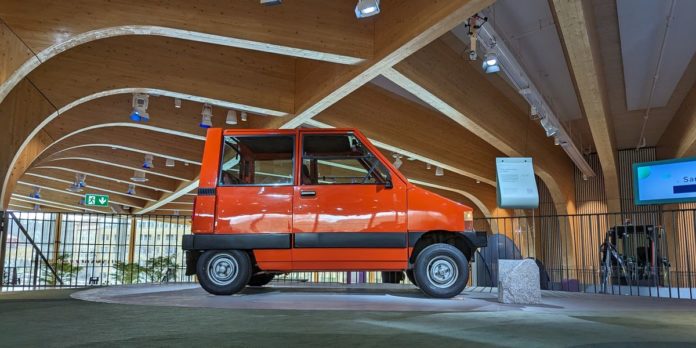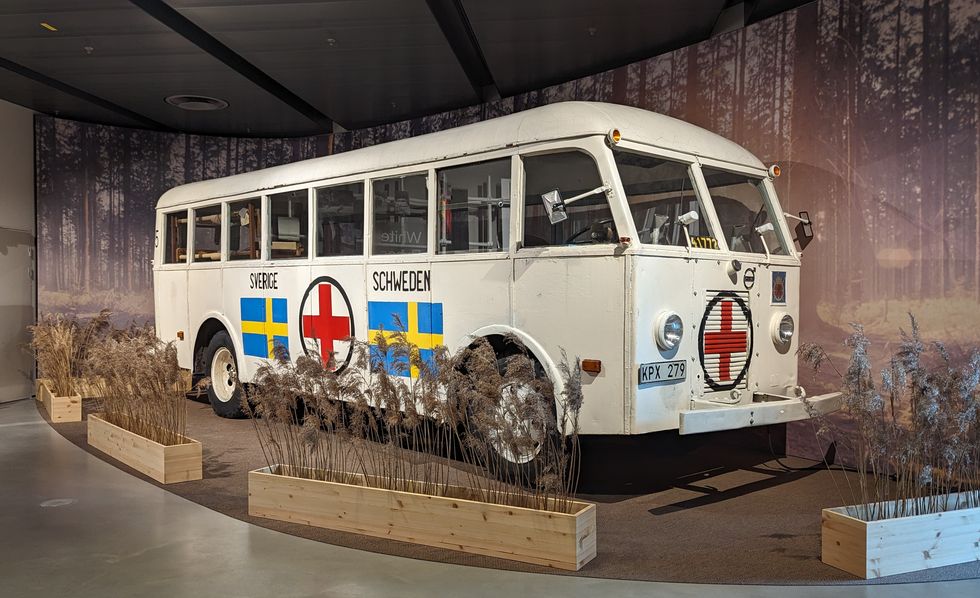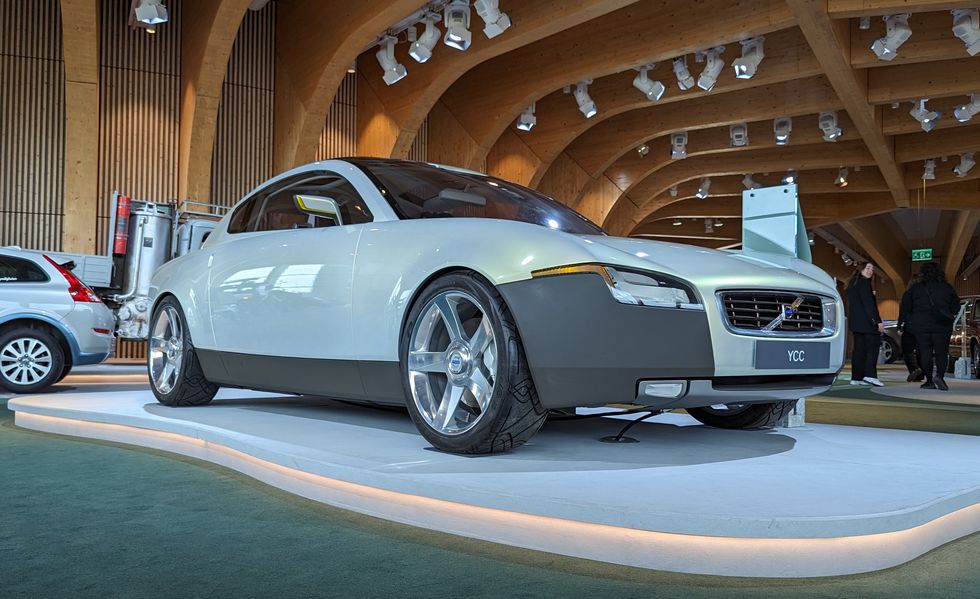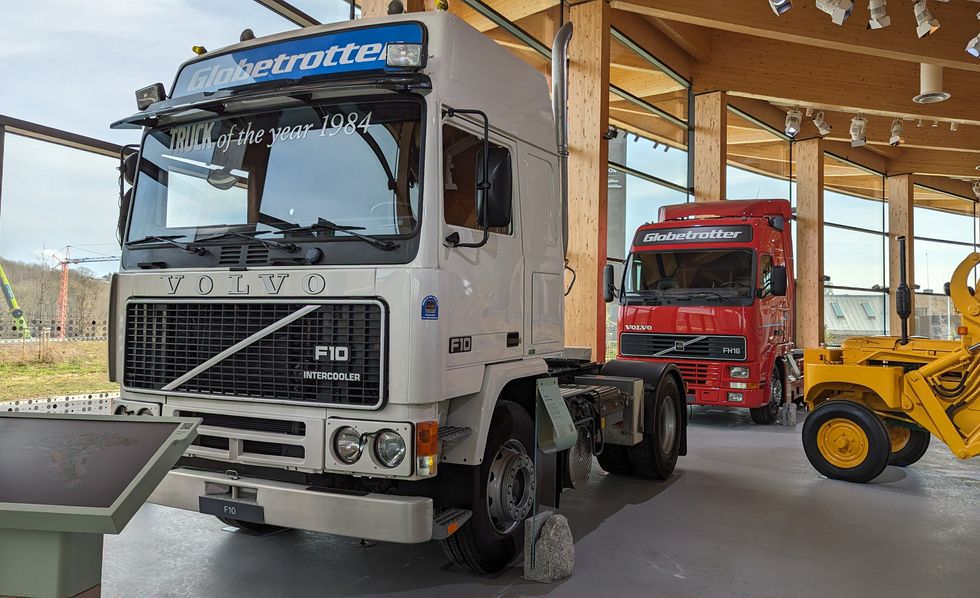- Volvo is about to open a new museum in Gothenburg, Sweden.
- The World of Volvo is situated near Volvo Group headquarters and only 14 miles from the Gothenburg airport.
- We got a behind-the-scenes look ahead of its grand opening on April 14.
BMW Welt, a stone toss away from the company’s HQ in Munich Germany, has Double Cones. The Porsche Museum in Zuffenhausen has a 911 kebab—or, as they call it, “Porscheplatz”—out front. And now, in the heart of downtown Gothenburg, Sweden, there are three giant tree trunks—the arms and legs of Volvo’s new museum, exhibit, delivery program, meeting place, and eatery—World of Volvo.
Volvo invited us to explore the new facility ahead of its grand opening on April 14, which by no accident is the very day 97 years ago that the Swedish automaker’s first vehicle, the four-door ÖV4, left its assembly line. The nearly 240,000-square-foot chunk of Gothenburg was designed by the Danish architecture group Henning Larson. It stands 14 miles from the Gothenburg-Landvetter airport and just 11 miles east of Torslanda, the home of Volvo Group headquarters and its oldest plant.
The space is Swedish beautiful. Its lack of extravagant shiny metals or spaceship style makes it feel real, welcoming, and warm. We overheard more than just a few fellow media guests compliment the spruce and pine fragrance that acts as a natural canopy over the structure’s smooth concrete floors. The top floor, home to several rentable conference halls and classrooms, conceals the nearby highway thanks to the tilted roof below it. It took four years to design and construct, using some 2800 tons of lumber, and a few leftover lamp bulbs from the SAAB gearbox building that once occupied a portion of its space.
World of Volvo is five stories tall, and while its entrance honors Sweden’s “Allemansrätten,” or “everyman’s right to roam,” with free admission, its grandiose event space, colorful and interactive exhibits, and restaurant run by Michelin-star chef Stefan Karlsson each require a handful of Swedish krona.
Its debut exhibit is a balance of Volvo’s history, its pledge to safety, and future products. There are distracted-driving simulations, VR goggles, and an area that lets you scoop rubber balls out of a pit with a mini Volvo excavator. One clever installation shows the role speed plays in a car accident, using a stack of wooden chairs. It’s an interesting way to see crashing without a seatbelt at 15 km/h (9 mph) versus crashing at 30 km/h (19 mph). The lesson? Not wearing a seatbelt is about as smart as falling headfirst from a stack of eight chairs.
Of course, there is no shortage of Volvo cars, concepts, trucks, and technology featured here. The Volvo Experimental Safety Car (VESC) is impossible to overlook. This concept, which originally debuted at the Geneva auto show in 1972, was a test bed for all types of innovative safety equipment: front and rear airbags, concealed headrests that would deploy during a crash, a steering wheel that would pull away from the driver during a collision, and a 6.5-mm F/1.8 rear-facing camera that would feed video to a CRT screen in the dash.
In another room, one of the White Buses sat parked. Painted white, with red crosses on the roof to avoid being bombed by allies during their attempt to ferry more than 15,000 prisoners to Sweden, these buses served a heroic purpose toward the end of World War II. The display is surrounded by literature about the nurses, drivers, and soldiers who carried such a dangerous undertaking.
The Volvo YCC was on display. We asked if we could take it home, but were told no. The YCC (Your Concept Car) originally debuted at the 2004 Geneva auto show and was created by an all-female crew for women. It had a special compartment to store a purse, a headrest designed to comfortably accommodate a ponytail, and washable seats. The team also gave the YCC gullwing doors and the special project would go on to win many awards for its design and effort.
There are other vehicles on display, such as tractors, boats, logging trucks, and semi-trucks. The white F88 from the 1970s wears its significance across the top of its cab. Globetrotter was the top trim level of Volvo trucks, and the moniker is still used today on its trucks specifically designed for long travel. That takes you back to a time when refrigerators, kitchens, and spacious cabs were inspired by companies building trucks in America.
The FH, Volvo’s biggest-selling truck ever, is on display behind the F88. It was the first to be built, in 1993. This FH12 was just the start to the Volvo trucks sold today, which are now offered with a range of electric, gasoline, and diesel powertrains. Exhibits big and small enter the space via a massive freight elevator just outside the building that can carry up to 48,500 pounds of Volvo history. Which is more ice wine than we’re able to drink in a single visit.
The World of Volvo building will become home to its Overseas Delivery service, making its location relative to the airport and assembly plant so crucial. The site, which is the result of a collaborative effort between Volvo Cars and Volvo Group, is intended to be the home of future product reveals, TED talks, and—we hope—Car and Driver editors, because we so desperately want to play with those excavators again.
Tickets are available at the World of Volvo website or can be purchased at check-in. Choose an annual pass to get a small discount for future events while enjoying unlimited visits throughout the year.
Yes, he’s still working on the 1986 Nissan 300ZX Turbo project car he started in high school, and no, it’s not for sale yet. Austin Irwin was born and raised in Michigan, and, despite getting shelled by hockey pucks during a not-so-successful goaltending career through high school and college, still has all of his teeth. He loves cars from the 1980s and Bleu, his Great Pyrenees, and is an active member of the Buffalo Wild Wings community. When Austin isn’t working on his own cars, he’s likely on the side of the highway helping someone else fix theirs.






